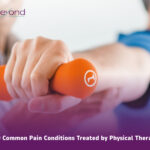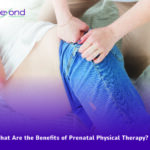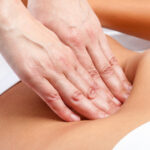Do you find yourself looking down at your phone or computer most of the day? Have you had trauma to your head or neck from a fall, car accident or sports injury? How to heal neck pain may be just as common as chronic low back pain. With increased sedentary daily work and decreased overhead activity the need to heal neck pain may be just as common place as healing low back pain. The added stress and strain of today’s modern technological world may be contributing to these chronic aches and than in previous decades.
Integrative Healing
In this third blog post of our “Heal Chronic Pain” series. This blog focuses on “How to Heal Neck Pain.” Dr. Carr Integrative Physical Therapy will provide an understanding of how chronic neck pain manifests. How unassuming areas of our body may relate or contribute to this chronic neck pain and what you can do about it.
There are many critical anatomical structures found in our neck. One of many reasons how to neck pain, may be a challenge. Patients may experience a variety of symptoms they wouldn’t necessarily experience anywhere else in the body. Unique symptoms related to neck pain may include but are not limited to dizziness, vision changes, ringing in the ears, vertigo, headaches, jaw pain, difficulty swallowing, difficulty taking a deep breath radiating pain into your shoulder blade, shoulder or down your arm.
Neck Anatomy
The human head weighs an average of 11 lbs (5kg). Aside from holding up our very heavy brain and skull. Our neck holds some of the most important structures in our body. There are 7 vertebrae in your neck and 5 discs. As well as 26 muscles that provide stability and mobility. Major blood vessels that feed our brain, face, eyes, nose and mouth. All allowing us to see, smell, taste and hear. Our thyroid, an extremely important gland for our metabolism and hormone function. Nerves feeding the skin of our head, neck, shoulders and arms. As well as nerves traveling to our throat to swallow, diaphragm to breath, heart to pump blood, digestive tract to communicate between our gut and brain, our vocal cords allowing us to speak, and our esophagus for food or liquids to travel from our mouth to our stomach.
Of the seven vertebrae, the first 2 vertebrae are called the atlas and axis. They make up 50% of your range of motion when you nod “Yes” or shake your head “No.” While the lower 5 vertebrae make up the other 50%. Many of the muscles, ligaments, nerves and arteries cross the upper and lower cervical spine. Therefore, an injury to the upper influences the lower and vice versa. They are very much interconnected. No matter the injury, addressing both the upper and lower cervical spine areas is essential to heal chronic neck pain as they influence each other.
Upper cervical spine
Whether you have suffered from a whiplash injury, head injury or are simply always looking down at your phone or computer. Any one of these may contribute to overstretched ligaments or nerves at the base of your neck and head. Ligaments that stabilize C1 and C2 to your skull and nerves that innervate your head. Headaches, vision changes, ringing in the ears, dizziness, nausea and vertigo are just some of the symptoms you may experience as a result of upper neck issues.
If these ligaments get over stretched from whiplash or looking down all of the time (a similar feeling to spraining your ankle over and over again) there is a loss of support and stability. When ligaments become weak, small and larger muscles tighten up to make up for it. Therefore contributing to the feeling of a loss of range of motion, neck tightness, weakness, muscle guarding and possibly TMJ symptoms.
Lower cervical spine
As mentioned earlier, the lower cervical spine is affected when the upper cervical spine is injured, and vice versa. The lower vertebra, discs, nerves also contribute to mobility and stability of the neck. The lower cervical spine’s nerves also feed into the muscles of the shoulders, shoulder blades and arms.
Understand that the location of your pain may not actually be the source of your pain. Often times, directly addressing the “muscle knot” in your shoulder blade, shortness of breath, or numbness in your thumb may not resolve your symptoms. Make sure you have your neck evaluated. The facet joints from your lower vertebra, C3 to C7, can refer to different areas in your lower neck, upper back and shoulder blade. The phrenic nerve is the nerve that feeds your diaphragm to breath. It comes from C3 to C5 in your neck. And the “carpal tunnel” nerve that can cause numbness, tingling or weakness in your thumb and index finger comes from the C5-6 nerve in your neck. These are just a few examples of how complex our body works. As the joints, nerves or discs from your lower cervical spine could be the cause of your symptoms referring to these areas.
The Bigger Picture
Aside from local structures in the neck affected by overuse or trauma. Understand that other areas in the body experiencing restrictions, weakness or dysfunction may play a small or large part in your healing process. These other areas of your body may contribute to the tension in your neck more than you realize. Affecting how to heal neck pain as a long term benefit.
Think about it. When you are sitting at your desk for long periods of time, this affects your whole body. Your lower back, hips, and core muscles. If you had a whiplash injury from a car accident, your whole body experienced the affects of the accident, not just your neck. Addressing restrictions throughout your rib cage and hips from air bags deploying and your seat belt locking, may positively improve your neck pain. Old abdominal surgeries or scar tissue not only affect how your low back pain heals, but can also create tension in your neck affecting how your neck heals. This is really important to keep in mind. Treating the anatomical areas in your neck is extremely important. However, it may be just as important to address other unassuming areas. Taking this whole body approach will assist you in healing your neck pain to the fullest.
Whole Body Physical Therapy
How to heal neck pain requires a whole-body perspective. Because our neck naturally allows us to freely turn our head in multiple directions. Similar to chronic low back pain, you may experience bulging discs, stenosis, instability, or a combination of these in your cervical spine. All of which can possibly interfere with nerve flow to your head, neck or arms. As mentioned earlier, with the dramatic increase in sedentary sitting activity, gravity is constantly pulling on our neck, as well as the ligaments and muscles that support it. Not only do neck muscles become weak and stiff, so can many other areas of our body.
Abdominal strength
One of the first activities patients may want to try begins with abdominal strengthening. The abdominal muscles are the first muscles to weaken with an onset of an injury. Not to mention as small as our neck muscles are, they will compensate and work harder than our abdominal muscles. Relaxing your neck muscles, while firing larger abdominal muscles will allow for decreased tension and stress in your cervical spine.
Breath work
It is amazing how often we forget to breathe or hold our breath. This can increase pressure into our rib cage and neck muscles. While weakening our diaphragm.
Lie in a supported position on your back with a pillow under your head so your neck can relax. Place your hands on your belly button and lower ribs. Inhale through your nose, slowly. This helps filter fresh oxygenated air through your nasal cavity. Feel your abdomen rise. Then, slowly, exhale out through your mouth like you are blowing out birthday candles. The longer and slower your exhale, the easier it is to take a large inhale through your nose.
Postural muscles
Do not to reach for the wand, ball or other fascial device to release the muscle tightness in your neck. Your neck is delicate and often needs more stability first. Strengthen the muscles between your shoulder blades or deep neck flexors (the abdominals of your neck) is more important. Once these muscles become stronger and more active. The muscles that are working overtime. The ones you are craving to stretch may start to relax on their own. These muscles and nerves sometimes need a distraction. By activating other muscle groups, these tight muscles can stop working in overdrive.
Hip Flexibility
Stretch your hip flexors. As most of us sit more than we should, our hip flexors contribute to poor posture contributing to “forward head posture.” Tight hip flexors can also contribute to weakening of our abdominal muscles. Gently, stretching these muscles may also help take tension off of your neck. Allowing the smaller muscles in your neck to relax and take a back seat. Although tiny, your neck muscles are mighty. Thinking they have to do all of the work all of the time. From all that sitting we do, you may be surprised how tight hip flexors can indirectly affect your chronic neck pain. Addressing this along with your abdominal strength. As mentioned above, may have a more positive effect in the long run than you realize.
Stress
Aside from the physical demands placed on your neck throughout the day. A very common complaint regards stress. Whether it’s stress from our external or internal environment. The food we eat, sleep, or lack there of. The general feeling of overwhelm because there is too much to do with not enough time. Stress has become a more frequent factor in day to day life. As mentioned in the original heal chronic pain blog, stress plays a huge part in optimal healing. Making sure to get a good nights rest, eating an anti-inflammatory foods, drinking plenty of water, and nourishing your mind and body with positive thoughts. Also plays a huge part in healing chronic neck pain and so many other chronic illnesses.
Conclusion
If you have been searching for a chronic neck pain solution, you may have heard of some of this information before. And some or all of the information may be new to you. No matter where you are in your healing process, know that more progress can be made. Your body needs more time than you may realize to heal. It is natural to make improvements and then plateau for a while. Don’t give up. These plateaus don’t mean that’s all you have got. Think about them as new set points for your body. As you try new avenues of healing or incorporate a whole body perspective you may be able to continue healing. Reaching new heights, new perspective and overall improved wellness and less pain.
















